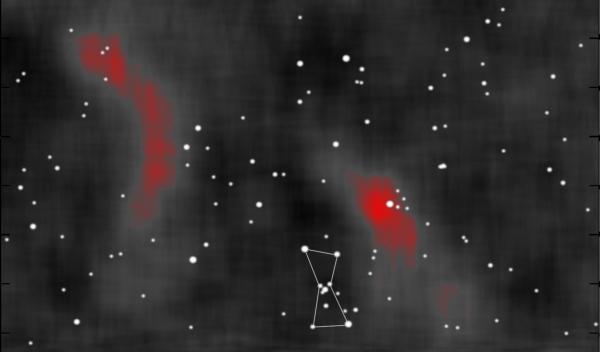[/caption] Last week's
announcement of a puzzling and unknown source of high energy cosmic rays
bombarding the Earth is now joined by another discovery of two sources of unexpected cosmic rays from nearby regions of space. A Los Alamos National Laboratory cosmic-ray observatory has seen for the first time two distinct hot spots that appear to be bombarding Earth with an excess of cosmic rays. "These two results may be due to the same, or different, astrophysical phenomenon, said Jordan Goodman, principal investigator for the Milagro observatory, commenting on last week's announcement by the
ATIC experiment
and the new discovery by his team. "However, they both suggest the presence of high-energy particle acceleration in the vicinity of the earth. Our new findings point to general locations for the localized excesses of cosmic-ray protons." The cosmic rays appear to originate from an area in the sky near the constellation Orion.
Researchers used Los Alamos' Milagro cosmic-ray observatory to peer into the sky above the northern hemisphere for nearly seven years starting in July 2000. The observatory is unique in that it monitors the entire sky above the northern hemisphere. Because of its design and field of view, Milagro was able to record over 200 billion cosmic-ray collisions with the Earth's atmosphere.
Cosmic rays are high-energy particles that move through our Galaxy from sources far away. No one knows exactly where cosmic rays come from, but scientists theorize they might originate from supernovae—massive stars that explode— from quasars or perhaps from other exotic, less-understood or yet-to-be-discovered sources within the universe.
"Our observatory is unique in that we can detect events of low enough energies that we were able to record enough cosmic-ray encounters to see a statistically significant fractional excess coming from two distinct regions of the sky," said collaborator Brenda Dingus.
Because Milagro was able to record so many cosmic-ray events, researchers for the first time were able to see statistical peaks in the number of cosmic-ray events originating from specific regions of the sky near the constellation Orion. The region with the highest hot spot of cosmic rays is a concentrated bulls eye above and to the right visually of Orion, near the constellation Taurus. The other hot spot is a comma-shaped region visually occurring near the constellation Gemini.
But the researchers cannot be sure they have precisely located the sources of the cosmic rays. "Whatever the source of the protons we observed with Milagro, their path to Earth is deflected by the magnetic field of the Milky Way so that we cannot directly tell exactly where they originate," said Goodman. "And whether the regions of excess seen by Milagro actually point to a source of cosmic rays, or are the result of some other unknown nearby effect is an important question raised by our observations."
A new, second-generation cosmic ray observatory has been proposed, which may be able to solve the mystery of the origin of cosmic rays. The experiment, named the High Altitude Water Cherenkov experiment (HAWC), would be built at a high-altitude site in Mexico.
Sources: UMD,
Science Daily
 Universe Today
Universe Today
